p. 417: “Often the saint was shown in the
company of his friend St Paul the Hermit: while St
Anthony was held by the Copts* to be the first monk,
St Paul was said to be the first hermit. When the
two were shown together they were always accompanied
by a raven that, according to St Jerome’s version of
the legend, diligently brought a loaf of bread every
day to their cave. In some icons the two men were
also accompanied by a pair of lions (see
icon below), again a
reference to St Jerome’s “Life of St Paul the
First Hermit” which tells how the lions helped
St Anthony bury his friend:
Even as St Anthony pondered how he was to
bury his friend, two lions came coursing,
their manes flying, from the inner desert
and made towards him. At the sight of them,
he was at first in dread: then turning his
mind to God, he waited undismayed, as though
he looked on doves. They came straight to
the body of the Holy Paul, and halted by it
wagging their tails, then crouched
themselves at his feet, roaring mightily;
and Anthony knew well they were lamenting
him, as best they could. Then, going a
little way off, they began to scratch up the
ground with their paws, vying with each
other to throw up the sand, till they had
dug a grave roomy enough for a man ...

Coptic
icon of Holy Paul the Hermit with Saint Anthony
The reason for my particular interest in the icons
of St Anthony was that during the Dark Ages the
saint was also a favourite subject for the Pictish
artists of my native Scotland, as well as for those
across the sea in Ireland. The Celtic monks of both
countries consciously looked on St Anthony as their
ideal and their prototype, and the proudest boast of
Celtic monasticism was that, in the words of the
seventh-century Antiphonary of the Irish monastery
of Bangor:
This house full of delight
Is built on the rock
And indeed the true vine
Transplanted out of Egypt.
Moreover, the Egyptian ancestry of the Celtic Church
was acknowledged by contemporaries: in a letter to
Charlemagne, the English scholar-monk Alcuin
described the Celtic Culdees as ‘pueri
egyptiaci’, the children of the Egyptians.
Whether this implied direct contact between Coptic
Egypt and Celtic Ireland and Scotland is a matter of
scholarly debate. Common sense suggests that it is
unlikely, yet a growing body of scholars think that
that is exactly what Alcuin may have meant.
There are an extraordinary number of otherwise
inexplicable similarities between the Celtic and
Coptic Churches which were shared by no other
Western Churches. In both, the bishops wore crowns
rather than mitres and held
T-shaped Tau crosses
rather than crooks or crosiers (compare
icons below).
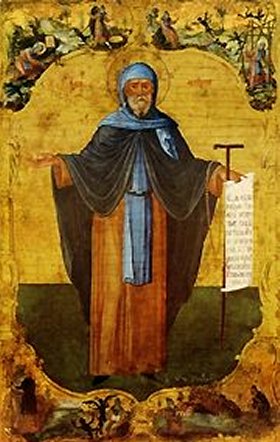
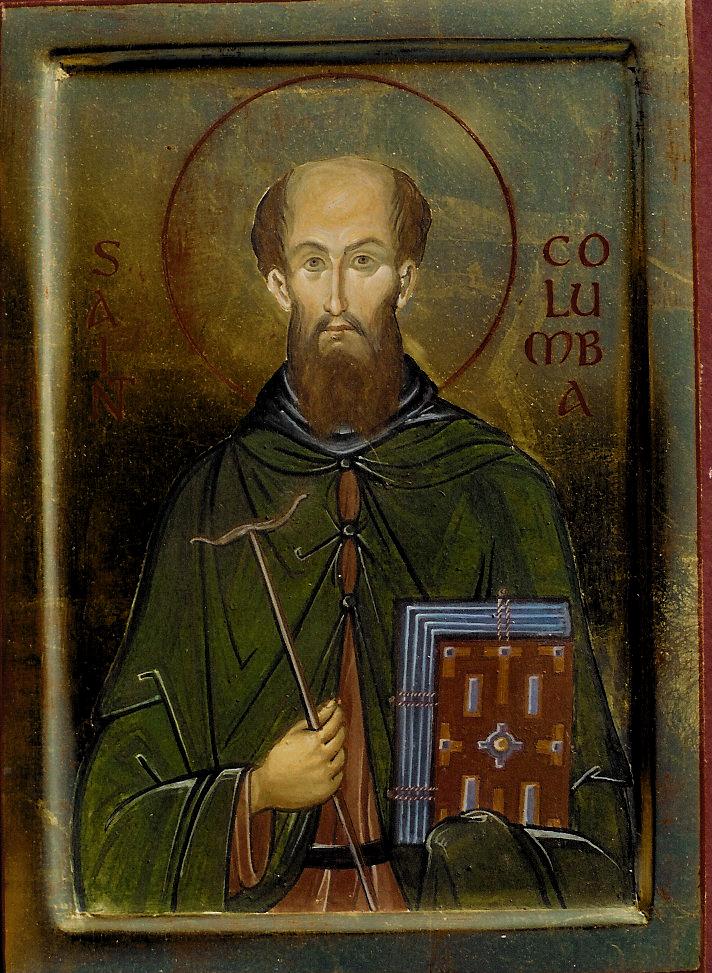
Saint Antony (Egypt)
Saint Columba (Scotland)
In both, the hand-bell played a very prominent place in ritual, so
much so that in early Irish sculpture clerics are
distinguished form lay persons by placing a
clochette in their hand. The same device performs a
similar function on Coptic stele – yet bells of any
sort are quite unknown in the dominant Greek or
Latin Churches until the tenth century at the
earliest.
Stranger still, the Celtic wheel cross,
the most common symbol of Celtic Christianity, has
recently been shown to have been a Coptic invention,
depicted on a Coptic burial pall (see
image below) of the fifth
century, three centuries before the design first
appears in Scotland and Ireland.
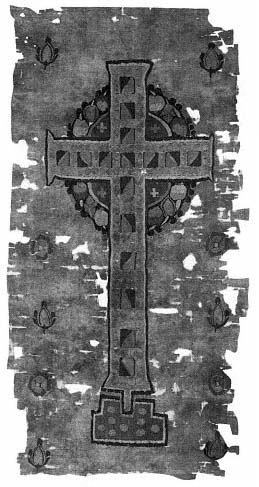
Coptic burial pall, fifth to seventh century.
138.4 by 68.9 cm. The linen and wool fabric
is embroidered with a developed ring cross,
a design that became common on Irish cross
slabs and high crosses in the eighth and ninth
centuries. The vertical shaft terminates in a
tongue that rests in a groove in the base, a joint
characteristic of timber architecture but not used
in stone construction.
Photograph courtesy The Minneapolis Institute of Arts.
Certainly there is a growing body of evidence to
suggest that contact between the Mediterranean and
the Celtic fringe was possible. Egyptian pottery –
perhaps originally containing wine or olive oil –
has been found during excavations at Tintagel Castle
in Cornwall, the mythical birthplace of King
Arthur. The Irish Litany of Saints remembers
‘the
seven monks of Egypt (who lived) in Disert Uilaig”
on the west coast of Ireland. But the fullest
account of direct contact is given by none other
than Sophronius himself. In his “Life of
John the Almsgiver” (the saintly Patriarch with whom
he and Moschos fled Alexandria in 614 A.D.),
Sophronius tells the story of an accidental voyage
to Britain – more specifically, in all likelihood,
to Cornwall – undertaken by a bankrupt young
Alexandrian aristocrat to whom the Patriarch has
lent money:
“We sailed for twenty days and nights
(reported the man on his return) and owing to a
violent wind we were unable to tell in what
direction we were going either by the stars or
by the coast. But the only thing we knew was
that the steersman saw (an apparition of) the
Patriarch (John the Almsgiver) by his side,
holding his tiller and saying to him: ‘Fear
not! You are sailing quite right.’ Then, after
the twentieth day, we caught sight of the
islands of Britain, and when we had landed we
found a famine raging there. Accordingly, when
we told the chief man of the town that we were
laden with corn, he said, ‘God has brought you
at the right moment. Choose as you wish either
one “nomisma” for each bushel or a return
freight of tin.’ And we chose half of each.
Then we set sail again and joyfully made once
more for Alexandria, putting in on our way at
Pentapolis (in modern Libya).
p.420:
“..As I stood outside the church, Fr. Dioscuros came
over and introduced me to the Abbot. As we chatted,
I happened to mention how St Anthony had once been a
highly revered and much sculpted figure in my home
country. Surprised, the Abbot questioned me closely
about the Pictish images of his patron saint, and I
described to him the scene shown on a particularly
beautiful seventh-century Pictish stone from
St Vigeans (near Dundee) which illustrates the scene in
St Jerome’s
Life of St Paul the First Hermit
where the two saints meet for the first time. They
eat together but cannot agree which of them should
break the bread. Each defers to the other, until
finally they ‘agreed that each should take hold
of the loaf and pull towards himself, and let each
take what remained in his hands’.
In the Pictish version of the scene, the two saints
are shown in profile as they sit in high –backed
chairs facing each other, with one hand each
stretched out to hold a round loaf. It was a very
different image, I said, from any I had seen in the
monastery, all of which showed St Anthony standing
full-frontal, staring into the eyes of the onlooker,
in the classic Byzantine manner.
‘You are wrong,’ said the Abbot, smiling
enigmatically. ‘We have your image as well.
Come, I will show you.’
...I looked where he was pointing. There, under the
outstretched arm of the saint, a much smaller scene
had been painted. Two figures, immediately
recognisable as Paul and Antony, sat facing each
other in a cave under a hill, on top of which grew a
palm tree. Both figures had one arm outstretched to
grasp a round loaf of bread with a line down its
centre. It was exactly the image sculpted by the
unknown Pictish artists in seventh-century Scotland.
p. 422: The only conceivable explanation of
the similarity of the two scenes – one in Scotland,
one in Egypt, whole continents apart – is the icon
in the library must be a late copy of a much older
Coptic original, an earlier version of which had
somehow made its way from Egypt to Dark Age
Perthshire, either by trade**, pilgrimage or in the
hands of wandering Coptic monks.
======================================
Notes
*
A Copt is a native
Egyptian Christian. Copts are the direct descendants
of the Ancient Egyptians. The Coptic (antichalcedonian)
Church is the portion of the Church of Alexandria
which broke away from the other Orthodox churches in
the wake of the Fourth Ecumenical Council in
Chalcedon in 451. Sharing a common heritage
previously with the Orthodox (Chalcedonian) Church
of Alexandria, it traces its origins to the Apostle
Mark. The word "Coptic" was originally used to refer
to Egyptians in general , but it has undergone a
semantic shift over the centuries to mean more
specifically "Egyptian Christian".
**OODE Note:
Cornish tin has also been
identified in Mycenaean bronze;
Britain has not been as isolated from the east in
ancient times as is popularly held. [With
thanks for this information to an Orthodox Celt,
J.D.C.]
======================================
(From a review of the book)
In
587 A.D., two monks set off on an
extraordinary journey that would take them in an arc
across the entire Byzantine world, from the shores
of the Bosphorus to the sand dunes of Egypt. On the
way John Moschos and his pupil Sophronius the
Sophist stayed in caves, monasteries, and remote
hermitages, collecting the wisdom of the stylites
and the desert fathers before their fragile world
finally shattered under the great eruption of Islam.
More than a thousand years later, using Moschos's
writings as his guide, William Dalrymple sets off to
retrace their footsteps and composes "an evensong
for a dying civilization"
======================================
ANCIENT CHRISTIAN MONUMENTS IN SCOTLAND DEPICTING
EGYPTIAN SAINTS
1. THE
PICTISH NIGG MONUMENT
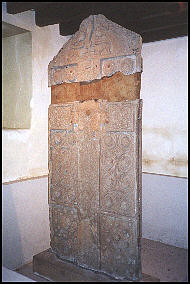
The Pictish Nigg
Monument, Scotland (above) and
explanatory notice regarding the
two saints with
raven and 2 lions engraved on it (below).
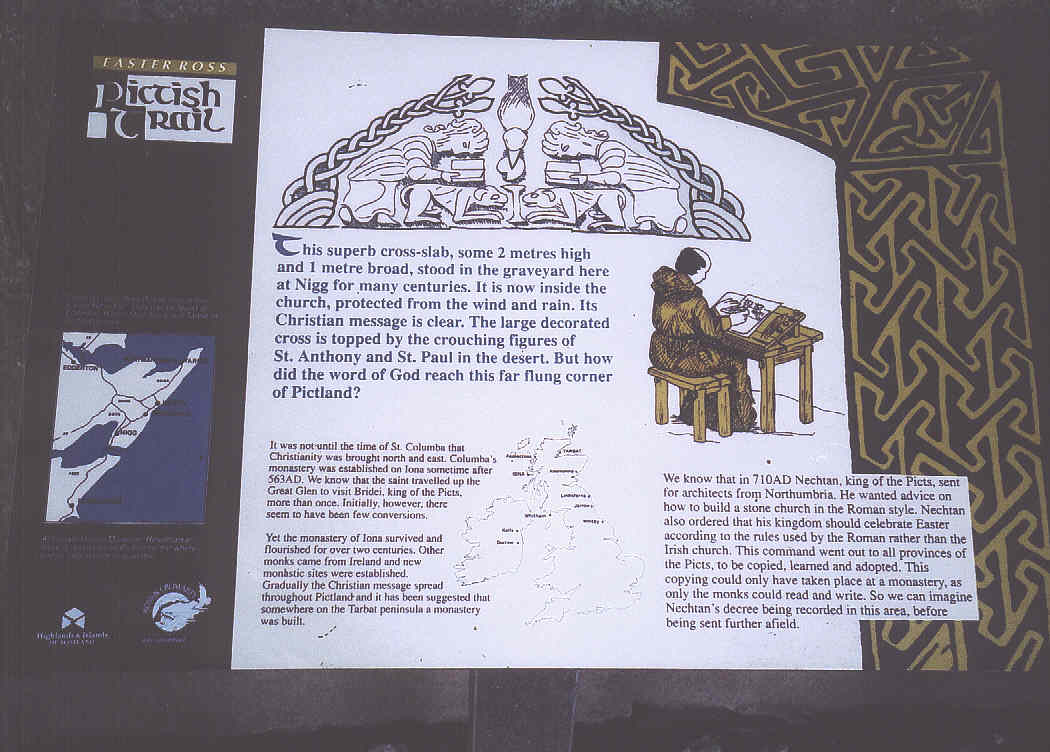 detail ->
detail ->
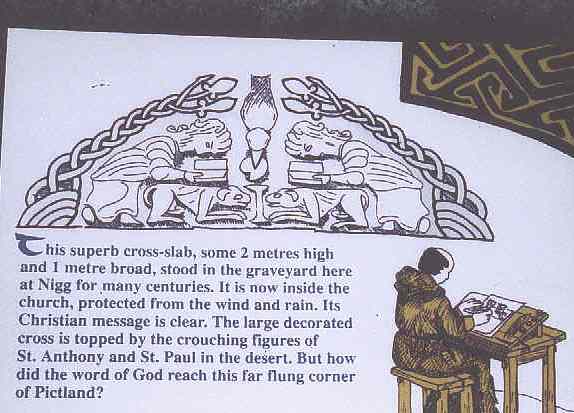
==================================================================
2. THE RUTHWELL
CROSS
The
Ruthwell Cross is one of the oldest Preaching
Crosses in Europe, and was first raised on the
Solway towards the end of the 7th century. It is
thought to have been created by monks of the
Columban (or Scotic) Church, as a protest
against the Church of Rome. The Roman Church had
sought to achieve supremacy in England by
expelling the evangelical Church of Iona from
Northumbria in the North of England, an area
geographically close to the far south-west of
Scotland where the cross was sited.
The
cross is eighteen feet high, decorated with
sacred carvings depicting scenes from the New
Testament, and with ancient Runic letters. It
was probably created in 664AD, after the Synod
of Whitby. At that meeting of church-men, the
presbyter
Colman - Bishop of Lindisfarne, found it
impossible to stand alone against the united
Roman Bishops, led by Wilfrid, all of whom were
committed to Roman supremacy. As Colman and his
followers made their journey homewards, they
raised a Preaching Cross at Ruthwell. In a
sparsely populated land with few church
buildings it was probably one of a series raised
throughout Scotland. It signified the
consecrated ground on which the Worship of God
could be conducted, and where the Sacraments
could be administered.
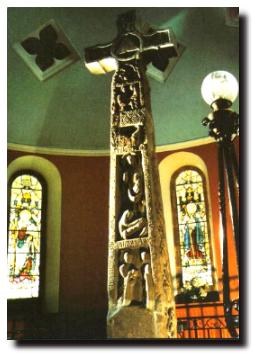
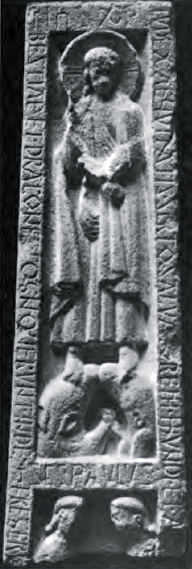
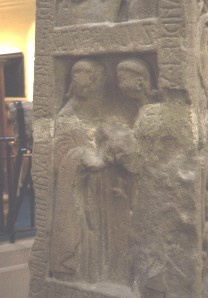
Detail
at the base of Cross - Hermit Paul and Saint
Anthony breaking bread in the desert, as told by
the Latin inscription : SANCTVS PAVLVS ET
ANTONIVS DVO EREMITAE FREGERVNT PANEM IN DESERTO
=====================================================
3. SAINT
VIGEANS PICTISH STONES - SCOTLAND
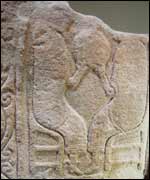
Detail of
Hermit Paul and Saint Anthony breaking a round loaf
of bread